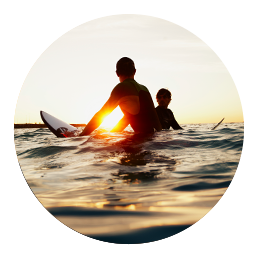 Shark activity map
Shark activity map
Switch on your Sea Sense.
Read more
Latest shark advice and warnings.
Read More










News & Alerts
Research finds surfer shark deterrent significantly reduces the risk of attack
22 May 2018- University research shows the Ocean Guardian Surf+, even in extreme circumstances, significantly reduces the risk of shark interactions by at least 60 per cent
- McGowan Government calls on NSW Government to release the final university report into shark deterrent effectiveness
- Subject to the final report, the Department of Primary Industries and Regional Development has recommended the Surf+ device be added to the personal shark deterrent subsidy program
Fisheries Minister Dave Kelly has today called on the New South Wales Government to immediately release a final Flinders University report that details the effectiveness of a range of personal shark deterrent devices.
A draft of the NSW Government report was assessed by the Department of Primary Industries and Regional Development's scientists. The test results show that even under extreme circumstances - chummed and baited waters - the Surf+ device reduced the risk of an interaction with a great white shark by at least 60 per cent.
The department also advised in normal surfing conditions, the Surf+ device may produce an even higher level of shark deterrence.
It also shows the Ocean Guardian's (formerly known as SharkShield) Surf+ device is the most effective, scientifically proven personal shark deterrent, designed specifically for surfers, on the market.
The department has concluded that provided no changes are made to the conclusions about the effectiveness of the personal deterrent in the final report, the device can be added to the McGowan Government's world-first personal shark deterrent subsidy program.
Comments attributed to Fisheries and Innovation and ICT Minister Dave Kelly:
"If the NSW Government releases this report today, WA surfers will be able to buy a university tested and proven surfboard shark deterrent this weekend.
"It is in the public interest that a surfboard shark deterrent that has been found to significantly reduce the risk of shark interactions, is made available to those most at risk as soon as possible.
"The department has assessed the draft Flinders University report prepared for the NSW Government, and determined the Surf+ device is the only personal shark deterrent device specifically designed for surfers to significantly reduce the risk.
"Following the review of this draft report, the department has recommended - provided there are no material changes in the final report - the Surf+ device can be added to the rebate program."
Comments attributed to Department of Primary Industries and Regional Development scientist Dr Dan Gaughan:
"Even in extreme circumstances - chummed and baited waters - the Surf+ device was proven to significantly reduce the risk of a shark interaction with a great white shark.
"When the Surf+ was activated, the white sharks were observed to visibly react at an average distance of 1.7 metres from the device.
"In less extreme situations - without chummed and baited waters - white sharks might be expected to be less motivated to feed. Under such circumstances, it would be reasonable to predict that the Surf+ may produce a higher level of shark deterrence."
Minister's office - 6552 6100
ADDITIONAL INFORMATION:
- The five devices were tested on white sharks at the Neptune Islands, located off southern South Australia. The Neptune Islands are a major fur-seal pupping location and this area is a recognised aggregation site for white sharks, where the likelihood of encounters is high enough to undertake valid behavioural experiments.
- The experiment consisted of each prospective device and a control (no device) being tested about 50 times using an experimental surfboard with a piece of bait attached.
- For each of the trials, chum and tuna baits were used to attract sharks to the vessel with the experimental surfboard being deployed once shark(s) were present and actively interested in feeding. Combined with the location where the study was completed, this represents an extreme situation in which to test the efficacy of deterrent devices.
- Each individual trial involved assessing the behaviour of white sharks attracted to a fresh bait attached to the experimental surfboard over a 15-minute period or until the bait or board was touched by a shark. A total of 297 trials suitable for analysis were completed.
- The experimental design included randomising the order of the deterrent device or control being used among different sets of trials completed across 18 days and five separate trips. This approach minimised the potential for individual shark habituation to impact the results.
- The overall design was therefore considered to be robust with the statistical methods applied to the results appropriate to test the relative efficacy of the five devices.
- Only one of the five products tested, the Surf+, produced a statistically significant reduction in the level of interactions with the bait/board compared to the control. The Surf+ reduced the percentage of baits/boards taken from 96 per cent (control) to 40 per cent.
- When the Surf+ was activated, the white sharks were observed to visibly react at an average distance of 1.7 metres from the device. The other products had no measurable effect on white shark behaviour during this study.
- The report acknowledged that testing at a seal colony using natural prey as an attractant in an area where white sharks are known to feed, represents an extreme situation compared to the conditions normally experienced while surfing. Consequently, the results presented in the report could be considered 'worse case' scenarios.
- In less extreme situations (i.e. non-aggregation sites, no attractant in the water), white sharks might be expected to be less motivated to feed. Under such circumstances, it would be reasonable to predict that the Surf+ may produce a higher level of shark deterrence.